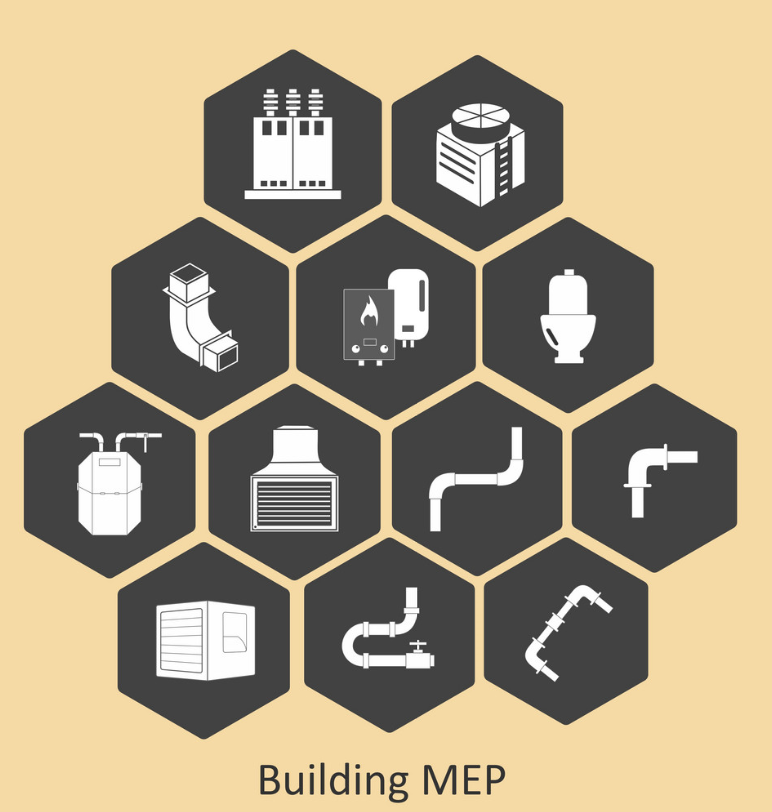Introduction: In the dynamic landscape of sustainable design and construction, MEP engineering plays a crucial role in ensuring energy efficiency

Electrical systems, mechanical systems, and plumbing systems make up a considerable amount of the development costs associated with building design. However, smart layout optimization of your MEP installation can reduce costs in building system design. In fact, you can accomplish this without decreasing performance. Performance optimizations can often be accomplished at the same time as cost reductions.
Keep reading, and we will discuss a few ways that you can reduce costs in your building system design.
Certain MEP components like boilers and chillers are expensive separately. By choosing the equipment of the best capacity to fit your building load, you can cut costs considerably. By the same token, duct systems and piping attached to MEP equipment will generally have a low cost per foot. The problem is that expenses can accumulate once you have the entire building design in scope.
In any building that uses air ducts or pipes presents an opportunity to reduce costs by optimizing the layout. In most cases, you can achieve full coverage of the structure using the shortest workable length of piping and ductwork. The same principle goes for electrical system installations, which currently travels in conduit and other types of the raceway.
Optimizing the Costs of MEP Installations.
The simplest way to optimize your ductwork, piping, and conduit costs is by choosing a qualified MEP engineering company to help with designing your project from the start.
You can adjust several factors in your building design process to achieve cost optimization:
The standard use of piping in structures is transporting potable water and wastewater. Piping has additional purposes in applications that involve fire protection and HVAC systems.
Here are two examples:
In automated sprinkler systems, piping is used to carry water to each sprinkler head. Fire protection piping is commonly painted red for identification purposes.
Common HVAC system configurations include hydronic piping. These systems use water to produce or extract heat from indoor spaces. For example, a chiller doesn’t cool the air directly; it actually cools water. Then, piping transports the cooled water on to cooling coils in nearby air conditioning units.
You can reduce the entire piping length needed for a structure with careful placement of mechanical rooms and equipment. Poorly located equipment areas lead to unreasonably lengthy piping runs, which just cost more money.
You can reduce the piping costs associated with automated sprinkler systems by using an optimized layout. In the end, your installation should use the smallest number of sprinkler heads to provide enough coverage for the structure. (and still, meet fire protection codes.)
New projects offer a great opportunity to optimize building coverage and costs. This is because fire protection engineers can work hand in hand with architects while the building design is being mapped out.
You can also optimize constructions that are already erected. However, in these cases, fire protection designs will need to adapt to the architectural features that are already in place.
Keep in mind that water pressure drops as it travels through piping. This is due to the friction between the water and the pipe’s inner lining. These losses become worse when the piping system is not optimized, leading to more expensive pumping costs and power costs.

Ductwork commonly shares the area above a ceiling with additional MEP components. Air ducts are heavier than piping, and design optimization should achieve both cost reductions and space reductions. Correctly choosing air ducts also opens up the possibility of reducing noise and vibration problems.
Similar to the way longer piping drives raise pumping costs, longer air ducts cause an improvement in fan power. Northeast states like New York and New Jersey where kilowatt-hour prices are higher than the US average. These states have a big problem with ventilation and pumping losses affecting their power bills.
The electrical design presents many possibilities for layout optimization as well. The same as with piping and ductwork, equipment placement can allow shorter circuit runs. Therefore, it is possible to decrease wiring and conduit costs and maximize energy efficiency.
Energy efficiency lowers the power consumption of electrical installations. This is because the supply voltage stays consistent, reducing the current.
Lower current supports the use of smaller conductors that run at a lower cost per foot.
As a result, smaller conductors can then fit in smaller conduit, which also saves money.
If you are applying energy efficiency techniques in an existing building, there is no need to decrease circuit capacities. Oversizing creates extra costs in new buildings and large scale renovations. Oversized existing circuits, in most cases, should just be left in place.
There are small savings achievable from downsizing an individual circuit. These savings can add up to larger buildings. Especially when it comes to choosing electrical service equipment. The cost variance is not a lot in 30 feet of #10 and #12 wiring, but a 500 kVA transformer, for example, it will cost significantly lower than a 750 kVA unit.
You can lower the ownership expenses of a structure significantly by implementing the right decisions during the design phase. You can also make noticeable savings in piping, wiring, and ductwork design. By carefully optimizing the layout of your MEP installations, you can save a ton of money in the long run. This is the main reason why professional engineers are an investment… They have experience with reducing building ownership costs, which can save you a ton in the long run.
About Author
InnoDez